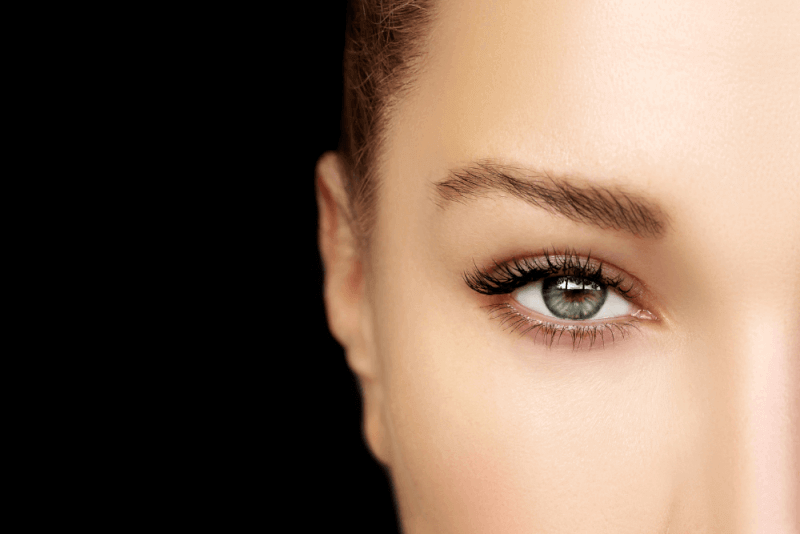Almond-shaped eyes, which are extremely popular today, refer to an eye shape where the outer corner is higher than the inner corner. This eye shape is also called slanted eyes because the outer edge of the eye is slanted upwards. The popularity of almond-shaped eyes is increasing due to their ability to provide a more expressive and deep gaze. Almond-shaped eyes are also known as fox eyes or bella eyes.
Almond Eye Aesthetics
There are many different aesthetic procedures available to achieve almond-shaped eyes, which have become one of the most preferred looks in recent times. Almond eye aesthetics not only enhances the attractiveness of the appearance but also helps reduce signs of aging around the eyes. The primary goal of almond eye aesthetics is to achieve a healthier and more vibrant appearance, and it can be combined with other aesthetic operations.
Although almond eye aesthetics can be performed in different ways, it generally involves shortening the ligaments around the eyes. These aesthetic procedures are divided into two main groups: surgical and non-surgical.
Despite involving surgery, almond eye aesthetics is often preferred due to the permanence of its results. Non-surgical options offer more temporary results, but the appropriate choice varies depending on individual needs. Therefore, the most accurate decision is made after an examination.
What is Almond Eye Surgery?
When deciding on almond eye surgery, both the patient's desires and expectations and the doctor's opinion must align. The patient's overall health condition should also be considered when making the decision, as local or general anesthesia is used during the procedure.
How is Almond Eye Surgery Performed?
Almond eye surgeries are usually performed under local anesthesia. The total duration of the procedure varies between 40 to 60 minutes. After the surgery, patients are discharged on the same day. Other aesthetic operations commonly combined with almond eye surgery include other eye surgeries and eyebrow lifts.
The typical steps followed in almond eye surgery are as follows:
- Before starting the surgery, the eye area is sterilized to minimize the risk of complications.
- Next, the area where the procedure will be performed is numbed with local anesthesia.
- An incision is made on the outer part of the eye. The incision is micro-sized, so there is minimal scarring after the procedure.
- If deemed necessary by the surgeon, excess tissue in the area is removed.
- The outer part of the eye is then pulled upward and anchored to the periosteum using special threads.
- Finally, the incisions are closed with stitches. The external stitches typically dissolve on their own after about a week.
Why is Almond Eye Surgery Performed?
Almond eye surgery is performed for various reasons. However, the primary goal of the procedure is to strengthen the muscles in the outer part of the eye. This results in a more slanted and upward eye appearance, while also eliminating signs of aging. This surgery also helps correct asymmetry between the eyes and addresses certain issues with the eyelids.
Who is Suitable for Almond Eye Surgery?
Almond eye surgery can be performed on people of all ages and genders. However, it is particularly preferred by those who wear glasses and spend long hours in front of a computer, as they may experience permanent damage to their eyelids. Almond eye surgery can correct these deformations. Besides, the following individuals often opt for almond eye surgery:
- Those with drooping eyelids
- Those with wrinkles around the eyes
- Those who want more striking eyes
- Those with deformation around the eyes due to aging
- Those with issues in the lower or upper eyelids
- Those with small eyes
- Those with asymmetrical eyes
- Those who want to have a younger-looking gaze
- Those who are not satisfied with the shape of their eyes
- Those with asymmetry in their eye structure
What to Consider Before Almond Eye Surgery?
Before undergoing almond eye surgery, patients should fast. On the day of surgery, makeup, skincare products, and perfume should not be used. Additionally, patients should provide a list of medications they are using to the specialist, and if necessary, discontinue certain medications. Lastly, alcohol should be avoided as it thins the blood, and smoking should be stopped to promote faster wound healing.
What to Consider After Almond Eye Surgery?
Since dissolvable stitches are usually used in almond eye surgery, there is no need to remove them. However, if non-dissolvable stitches are used, they should be removed after about a week. Other post-operative care instructions include:
- You can take a shower 24 hours after the surgery.
- It is recommended to sleep on your back on the day of surgery.
- No cosmetic products should be applied to the face within 10 days after surgery. Depending on the patient's skin characteristics, this period may extend to 15 days.
- Avoid environments with excessive heat, such as saunas and baths, during the healing process.
- If the doctor prescribes medication, it should be used regularly.
- If the patient has a regular exercise routine, they should pause it for a while.
- If any unexpected situation occurs during the healing process, the doctor should be consulted as soon as possible.
Non-Surgical Almond Eye Methods
Almond eye aesthetics can be performed not only with surgical methods but also with non-invasive methods. Various techniques can be used for this purpose. The non-surgical almond eye aesthetic methods include:
French (Thread Lift)
Thread lift, used for various aesthetic procedures, is also utilized in almond eye aesthetics. In thread lift almond eye procedures, the area is first numbed with local anesthesia. Then, a cannula is inserted from the temple area toward the outer part of the eye. Special threads designed for thread lift are passed through this cannula. However, the other end of the thread is not brought out, ensuring only a single open wound. Afterward, the cannula is removed, and the desired shape is given to the eye. The entry point closes the next day. In each procedure, 4-6 threads are used. Bruising and swelling may occur due to the procedure, but these usually resolve within a week.
The longevity of almond eye aesthetics performed with the thread method varies between 6 months and 1 year. The threads used dissolve on their own within 3 months, promoting the formation of collagen fiber networks. Some types of threads take up to 9 months to dissolve, offering longer-lasting results. Generally, the longevity of thread lift procedures is longer, but due to the differences in the fat and tissue around the eyes compared to other parts of the face, the duration may be shorter.
After almond eye aesthetics performed with the thread method, it is essential to keep the area clean. Additionally, no products should be applied to the face on the day of the procedure. After the procedure, you should sleep on your back for a week and avoid massaging the area.
Almond Eye Filler
The patent for almond eye filler was obtained by a Turkish doctor. It helps correct issues such as hollowing of the upper eyelid, sagging of the outer part of the eyebrow, and hollowing of the lower eyelid.
Before almond eye filler is applied, the patient should be examined and necessary planning should be made. During this planning, the points where the filler will be applied are determined, and the procedure is then performed.
The area to be treated is sterilized and then numbed locally. Cannulas, which are blunt-tipped needles, are used in the procedure. Hyaluronic acid is used as the filler material. Cannula needles are preferred to prevent bruising. The procedure takes approximately 15 minutes and is performed in a single session. However, a second session may be required if necessary. The results of the procedure last between 1.5 to 2 years.
Botox
Botox toxin relaxes the muscles around the eyelids for a while, giving the eyes an almond shape. Additionally, an eyebrow lift can be performed to elevate the outer part of the eye, resulting in a more slanted appearance.







